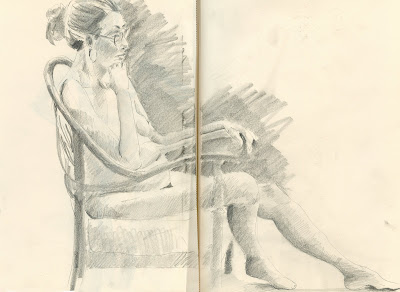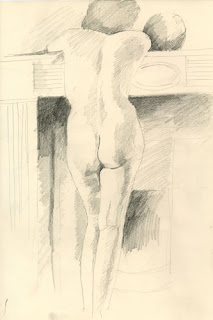 Drawings from a life class in Penzance
Drawings from a life class in Penzancepencil and graphite stick in a sketchbook
copyright Katherine Tyrrell
So - I've developed a draft of a guide to life drawing and life classes. I've also decided to try something new. The complete guide has been compiled in pdf format and is available to download from my website.
 What the guide covers
What the guide coversA Making A Mark Guide: Life Drawing and Life Class provides answers to the following:
- what is life drawing?
- what are the benefits of life drawing?
Life drawing teaches you how to see
Life drawing teaches you how to draw what you can see
Life drawing enables you to develop your own style of drawing
- practical aspects of a life class
- where can I find a life class?
- what do I need to take?
- what should I expect - of the place, the people and how it all works
- what I'm really worried about..... and the answers to the frequent concerns of people who've never enrolled.
Copyright applies and all rights are reserved in relation to commercial use. The guide is only free to the individual who downloads the document and then uses it for their personal educational use.
I'm expecting to convert it in future to a shorter version which will be free and a longer version which will be priced. So if you want to take a look I suggest you download it now!
Version 1.0 must NOT be copied nor priced and sold, nor used in a fee-paying workshop or any other commercial setting unless a licence has been granted by me and a fee paid (which will vary according to usage). Contact me for further details.
Feedback and follow up
What I'd very much appreciate is feedback on the layout and content of the guide. Also please let me know, via comments below, if there are any matters which I've left out but which you'd really like the answer to.
I'm planning a follow up post which will be about tips for drawing in a life class and links to any other useful sites for those contemplating life drawing.
This is a great little guide Katherine. I think you've touched on all of the points most beginner (or seasoned) artists would be interested in for life classes.
ReplyDeleteThe layout is clean and simple and easy to read.
My only comment would be to reinforce the fact that there are male and female models. Many people, especially men - and some women - who attend life classes are uncomfortable if there is a male model. They shouldn't be, but society seems to have kept the domain of art modeling as a female only reserve.
The artists don't usually know from week to week who the model will be. Rather a nice surprise in my eyes, the not knowing in advance.
As an artist who has gone back to life drawing after a long absence, I can only encourage others to do so. Its a bit of a learning curve after a lengthy break, but very enjoyable and beneficial to drawing skills.
This is an incredibly helpful guide Katherine! I just had time to scan it before going on to morning chores but look forward to geting back to reading it in depth. I can't think of a more useful tool for people who have not drawn the model from life. Well done!
ReplyDeleteHi Katherine,
ReplyDeleteI think you have covered the potential questions someone might have, who intents to visit a life drawing class, quite well.
Maybe I have an additional little suggestion: when I started with wood carving (sculptures) actually BEFORE I started with painting I was facing the same problems: my drawing skills had become quite rusty. Now drawing skills are essential for sculpting one would suspect - especially when you intent to sculpt human bodies. What I did, was sitting in front of a huge mirror and drawing all those shapes and forms etc from my own body. This may be of help for anyone who fears to simply draw not only naked bodies but bodies which are not perfect any more. I even took another mirror to be able to see the "backward" parts - re-checking again and again whether I got them right. Believe me - if someone would have seen me he would probably have called the people from the loony bin.
The essence of what I am saying is, that you get used somehow to all those crinkles and little hills and other imperfections that much, that you won't be aware of a foreign body any more. You learn to see much quicker and you get less frustrated when you start the real thing.
I can only say it helped ME tremendously although I have heard people say that this is still not the same as drawing from a model. I would say there is actually no difference besides that it is a bit more comfortable to draw a model than to bend your own parts in impossible directions - LOL!
I think your layout and approach are excellent, Katherine. This article is certainly an icebreaker and should encourage many (who can find one!) to join a life class.
ReplyDeleteThe only addition I can suggest (and you probably have planned it anyway) is a couple of tips for identifying and plotting the position of the major lines on the page.
And finally a question - You mention using oils on oiled paper. What does 'wiped down at the end' mean?
Thanks for all the comments so far - I'll be trying to see how I can incorporate them into the revised version.
ReplyDeleteThe next publication will be about some tips for actually setting about doing a life drawing.
Robyn - I'm not an oil painter so I'm guessing here. I do know there is something called oiled manila and I'm not sure whether this is what my friend used to use. I do know it was a special sort of paper for oils. When he wiped down at the end he removed his painting. The class was to practice rather than to produce 'great art' so he didn't feel a need to keep what he produced in class. He told me that the small residue of oil left behind after the wiping down soaked into the support and it actually became easier and easier to paint on the more he used it.
Thanks, Katherine. I felt a bit silly asking but now I'm glad I did.
ReplyDeleteBy the way, your posts of Sydney sketches is causing major homesickness. I won't be able to resist looking though.
You wait until I get to the menus - then we'll be seeing real heartache! ;) I'm looking forward to hearing your comments on the Australia series Robyn.
ReplyDeleteKatherine, this is a wonderful resource for someone hesitating about starting a life drawing class or group. I especially appreciate your comments about the fear of confronting a naked body, which really does bother a lot of people until they realize that when you're drawing you have no time to think abut anything else, and that horrible feeling that you can't really draw at all when confronted with the difficulty of rendering the human form from life. I wish I'd known that others feel that way too when I was first beginning to do this again!
ReplyDeleteThanks for posting this.
This guide is super, Katherine - hopefully will encourage many to try out a life drawing class. You got me to go and sift through rolls of old drawings, photograph and file some of them before the fish-moths completely reduced them to lace. Your oil painter friend had a good point there, though sometimes you produce something that you think just might be worth keeping. I think a good, sensitive tutor to begin with can't be over-estimated to get you through the first wobbles, though I know they're few and far between.
ReplyDeleteOne of the best books I've read about drawing is,
ReplyDeleteUndressed Art: Why We Draw by Peter Steinhart
It's great for life drawing. I'm addicted to my sessions at Disney (I don't work there presently and have to sneak in - in true addict style).
Really enjoyed reading the booklet and visiting all those wonderful blogs including Casey's post that I had missed!
ReplyDeleteOne thing that you might consider adding is how one can prepare before join a Life Drawing class to get the max. benefit. Thanks for the download :D
Another point that came to me is the addition of some generic life class sketches perhaps? Just to show what the average model poses are like?
ReplyDeleteIt may take away some of the fear factor.
Thanks for all the comments - I'll take them on board for the revision of this part and the next part of this publication
ReplyDelete